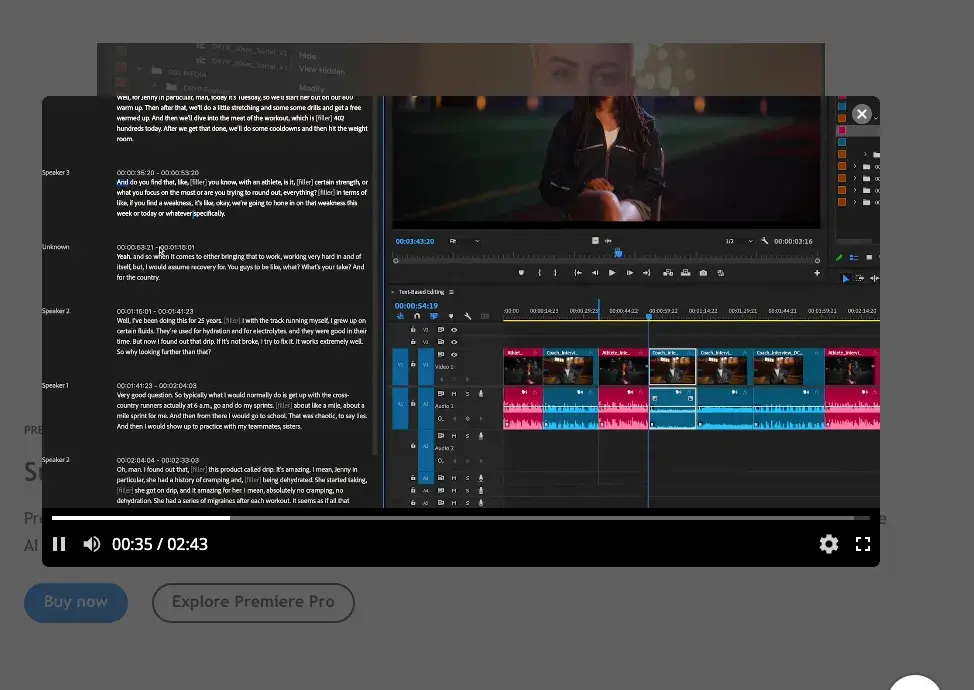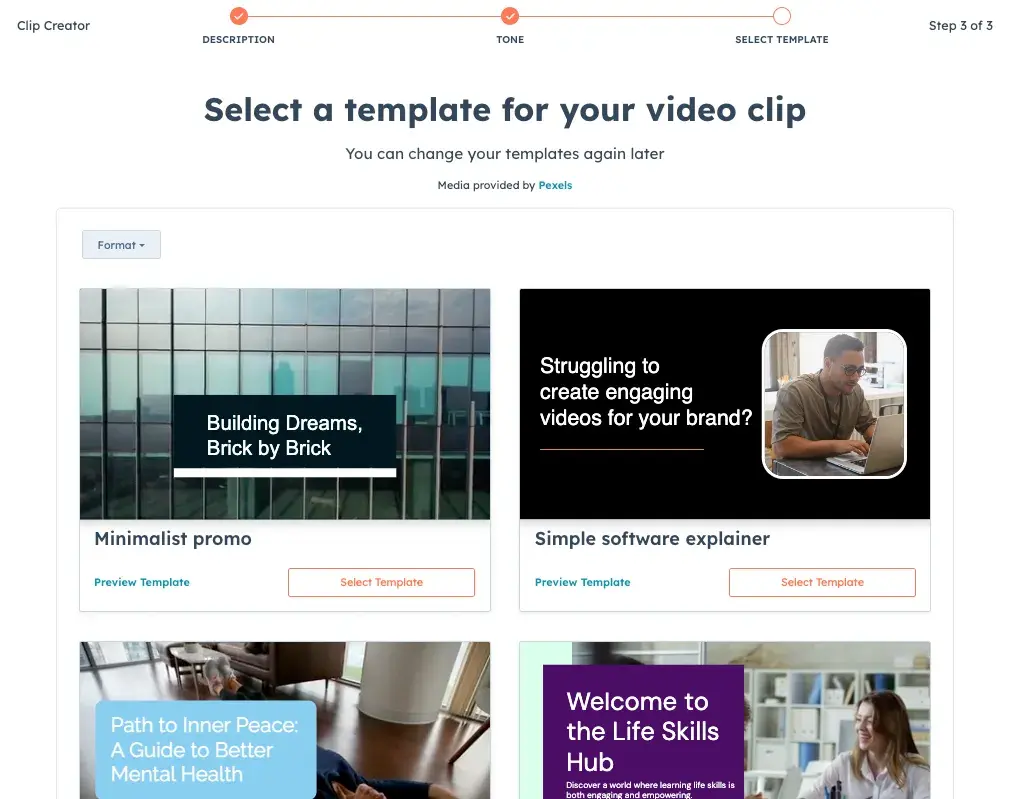It’s hard to ignore the fact that video is now a leading trend for marketing teams. I mean, even LinkedIn has jumped on the bandwagon by prioritizing video content (now, whether or not you agree with that, it is a conversation for another day, but I digress).
The truth is that video is here to stay, and marketing teams are investing more in it than ever before.
With 2025 just around the corner, I decided to take a deep dive into some of the latest HubSpot data, including the 2024 Video Marketing Survey, to get a clearer picture of what trends are shaping the field.
I also spoke with a few experts to get their insights on how they’re planning to invest in video marketing as we move into the new year.
Table of Contents
How much does video marketing cost?
The short answer? It varies wildly. You might spend a few hundred dollars on simple videos or tens of thousands on professional productions.
Typically, the biggest expenses fall into a few categories:
- Production. Costs for scripting, filming, and shooting, which can range from affordable for smaller teams to expensive for large-scale productions.
- Post-Production. Editing, adding effects, and finalizing the video. As content gets more polished, this becomes a bigger part of the budget.
- Promotion. Social media ads, paid search, or sponsored content to get the video in front of the right audience.
- Tools. Software for editing and video performance analytics, plus any subscriptions to specialized video platforms.
Looking ahead to 2025, I think we’ll see more teams leaning into AI tools to reduce costs, especially in production and post-production.
With the rise of short-form videos, brands might shift toward creating more frequent, lower-cost content for social platforms.
And while social ads will still be a major spend, I expect personalized, interactive video formats will become a bigger part of the budget as brands look for new ways to engage audiences.
How much are marketers spending on video marketing?
The numbers tell an interesting story. Our 2024 Video Marketing Survey shows marketers are putting a significant amount of their total budget into video.
And it’s paying off — 52% report high ROI, while 47% see average returns.
Most marketers that I spoke with plan to increase their video budget next year.
It makes sense when you look at the impact: 52% cite brand awareness as their primary goal, and 41% say video helps customers understand their products better.
What’s the typical budget breakdown? According to digital transformation expert Suriel Arellano, here’s how businesses usually slice it:
- 40-50% on production
- 20-30% on promotion
- The rest on talent and marketing
How AI Is Making Video Marketing More Affordable
Video marketing can get expensive quickly — whether it’s for production, post-production, promotion, or analyzing results.
But AI video tools are seriously changing the game, helping marketers like myself reduce costs across all stages of the process.
Here’s how I’ve seen AI make video marketing more cost-effective.
1. Production Stage: Brainstorming & Scripting
Creating a video from scratch often involves hours of brainstorming, scripting, and outlining. AI tools can significantly speed up this process, reducing the time spent on these tasks.
For example, ChatGPT or Breeze can assist in quickly generating video scripts or brainstorming ideas. By simply providing the AI with a few key details about the video’s objective and audience, marketers can generate entire scripts or outlines in minutes.
This saves both time and money, especially if you have limited resources.
Now, as a professional writer, I should add a disclaimer here. I certainly don’t advocate for ChatGPT replacing human creatives, including writers. A skilled scriptwriter will bring a level of expertise your project desperately needs.
However, I do recommend using ChatGPT to help you brainstorm new ideas or angles and polish certain aspects of the script.
2. Post-Production: Editing & Effects
Once your video is shot, the editing phase can be one of the most expensive stages, especially if you’re hiring a professional editor. AI tools are helping reduce post-production time though by automating many of the tedious tasks.
The cost of editing a video could rack up thousands of dollars easily. AI-powered tools like Descript and Adobe Premiere Pro can automate video editing tasks such as cutting, adding subtitles, and even creating social media-friendly formats.
One of the coolest editing features I’ve seen is text-based editing.
Essentially, you can edit words from a video transcript, and the editor will clip the video accordingly. Given that I have extremely limited video editing skills, I love how easy this is. See it here in action.

3. Promotion: Ads & Audience Targeting
Once your video is ready, promoting it to the right audience is crucial.
Traditional ad spend can quickly add up, especially if you’re relying on manual targeting and content creation. AI tools make it easier to optimize both your promotion strategy and your ad spend.
You can use machine learning to optimize ad placements, identify the best audience, and adjust campaigns in real time to reduce cost per conversion.
You can also use AI-powered translation tools to create multilingual versions of your videos. It can be helpful for reaching international audiences without the expense of hiring multiple voice actors.
Affordable Video Marketing Techniques
1. Weigh your options.
According to our video marketing data, 69% of video marketers surveyed own production equipment while 10% rent, and the remaining group does both. But which approach is right for your brand? Let’s break it down:
|
In-House |
Agencies |
|
|
Cost Structure |
Lower cost per video, higher upfront investment. |
Higher per-video cost, no equipment investment. |
|
Quality |
Good for simple content, limited by team skills. |
Professional quality, access to expert talent. |
|
Time |
Quick turnaround for simple projects. |
Longer lead times but consistent delivery. |
|
Control |
Full control over process and edits. |
Less direct control but professional management. |
|
Best For |
Regular, simple content needs (social media, product demos). |
Complex projects, high-production value content. |
The choice often comes down to your content type and frequency.
For instance, if you’re a makeup brand creating regular tutorial content, in-house production might be perfect — you just need good lighting and a camera to showcase products in action.
However, if you’re a travel brand needing cinematic destination shots with professional talent and multiple locations, an agency could actually be more cost-effective.
Most smaller brands (those with 200 employees or less) report better ROI when working with outside agencies, particularly for high-production value content.
But if you’re planning to create frequent, simple videos for social media, building an in-house team could be a smart long-term investment.
2. Separate need-to-haves from must-haves.
If there’s one piece of video equipment you should focus on, it’s lighting.
Many believe that having the best camera does the trick, but the truth is that lighting is what makes or breaks the quality of a video.
Lighting sets the tone and mood of a video, two elements you need to maintain your audience’s attention in a video.
Sound is another area to splurge on — specifically your mics. This will enhance the quality of your video, especially if you have to settle for low-end cameras.
As for everything else (the camera, the lens, the accessories), I think these are great add-ons, but if you’re on a budget, you can make do with low to mid-range options while still getting a high-quality result.
Pro tip: When you’re filming with a smartphone, I recommend shooting in landscape mode for YouTube but vertical for platforms like TikTok and Instagram Stories. This saves you from having to reshoot or crop later.
3. Focus on engagement over production value.
While 40% of marketers emphasize the importance of engaging video editing, you don’t need expensive software to create compelling content.
What matters most is capturing attention quickly (51% of marketers agree this is crucial) and telling an engaging story (37% prioritize storytelling and scriptwriting).
Pro tip: “Localization and personalization of video content will be a priority in 2025 because it is easier and more affordable than ever thanks to AI,” says Matt Panousis, co-founder of Monsters Aliens Robots Zombies, an AI-enabled VFX studio.
So, finding ways to personalize and humanize your content will be a key aspect of engaging your audience.
4. Use free editing software.
If you’re part of a small business or team that’s trying to create a video marketing strategy without spending much money, don’t worry.
You can use the awesome video tools that come with smartphones, and you can find good video editing software. Some of this software is even free.
One of these tools is HubSpot’s Clip Creator — which can convert text into engaging videos for your business. You can start from a template or generate a video with AI.
I tried creating a few for my own freelance business and loved getting to experiment with different versions.

Get started with HubSpot’s Clip Creator.
5. Involve SMEs for educational content.
Educational videos are one of the most effective content types in 2024, and involving Subject Matter Experts (SMEs) on your team can help you create high-value content without the high cost. SMEs can provide:
- Expert Insight. Adding value to your content with authentic, credible knowledge.
- Efficiency. SMEs are often quicker at delivering accurate and valuable content, which can reduce the need for extensive scriptwriting or research.
- Affordability. Instead of paying for external experts or influencers, your own team members can provide the same level of expertise.
6. Use more video on social media platforms.
The most effective way to promote videos is on social media platforms, with 69% of marketers saying it’s the most effective strategy for reaching audiences.
The best part? It’s essentially free if you already have a strong following. We’ve also seen that you don’t need a massive advertising budget to reach your target audience, so there’s no reason not to try.
My favorite hack here is finding ways to repurpose your content. For example, you can take a single piece of content and turn it into a YouTube video, several TikTok clips, an Instagram reel, and so on.
Video Marketing Is Worth the Investment in 2025
Video marketing can feel overwhelming, especially when you’re working with a tight budget. But here’s what the data is telling us: you don’t need Hollywood production value to create content that resonates with your audience.
With 52% of marketers seeing high ROI from video and 41% saying it helps customers better understand their products, it’s clear to me that video is definitely worth the investment.
Focus on what matters most: capturing attention quickly, telling engaging stories, and getting your content in front of the right eyes through social media.
And with AI tools making video production more accessible than ever, I believe there’s never been a better time to start creating videos that connect with your audience — without breaking the bank.
Editor’s Note: This post was originally published in March 2016 and has been updated for comprehensiveness.
![]()

![→ Access Now: Video Marketing Starter Pack [Free Kit]](https://no-cache.hubspot.com/cta/default/53/8f27c677-d952-4663-8787-bf65c6a1ecf2.png)
Recent Comments